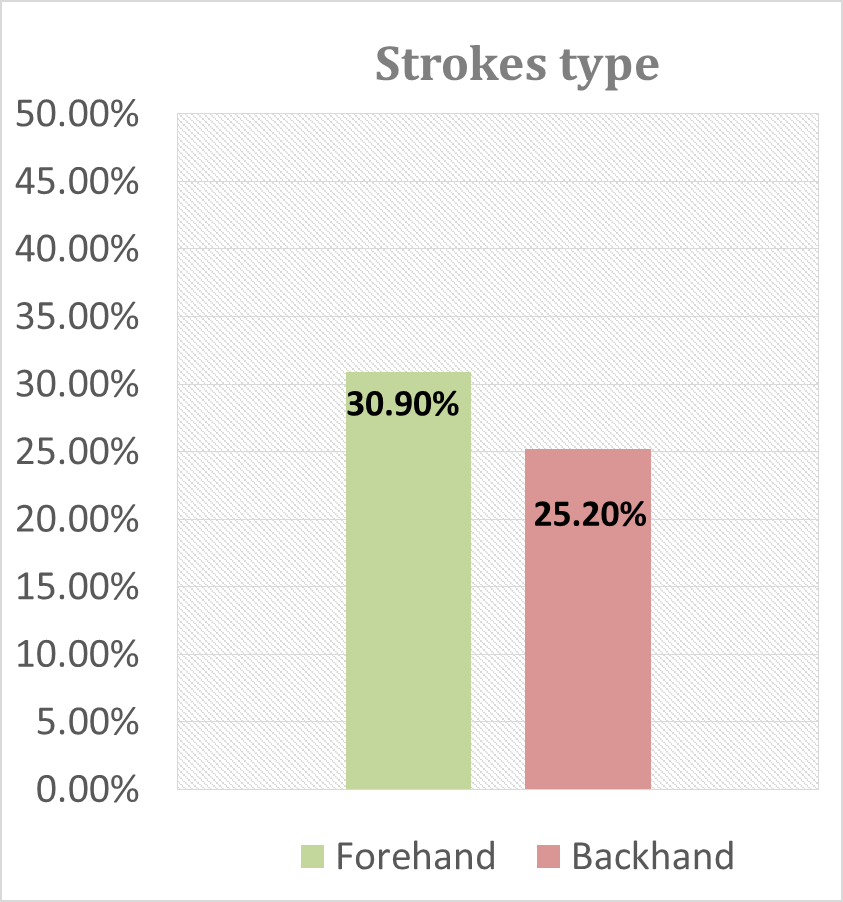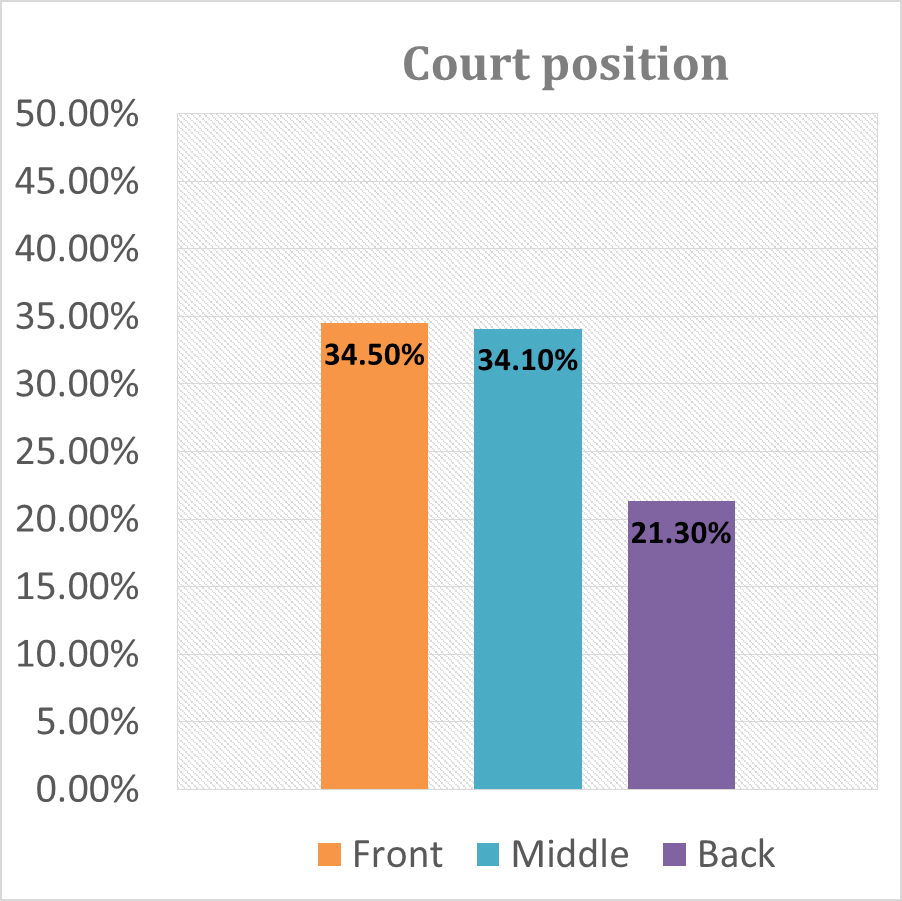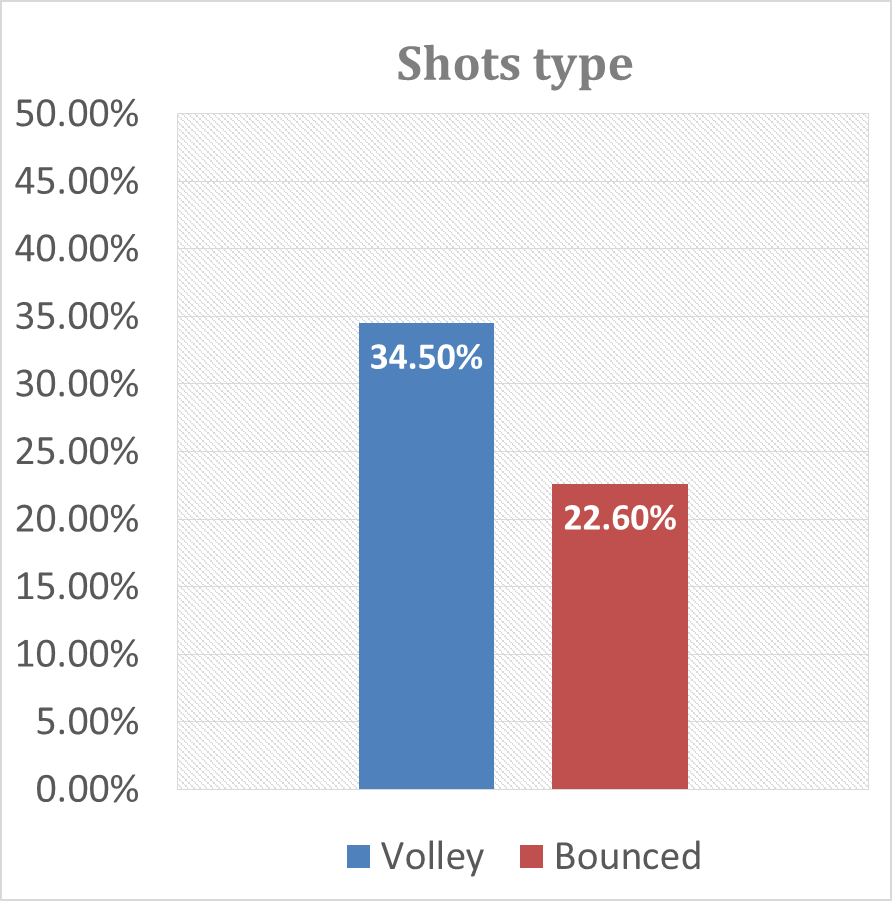Abstract
Squash is a popular sport practiced around the world by millions of people. In the last few years, this sport started being played more and more in Romania. Squash is perceived as a very dynamic sport activity challenging at the same time the physical capacities and the technical skills of the players. In racquet sports, technical skills are revealed by the ability to hit a shot accurately toward a targeted area. The aim of this study was to evaluate the current technical level of the Romanian players using the Hunt Squash Accuracy Test (HSAT). Eleven male and female squash players, from 2 clubs, performed HSAT which consists of 375 shots across 13 different types of squash strokes on both the forehand (FH) and backhand (BH) side. The Romanian players (32.4 ±12.5 yo; 76.4 ±18.6 kg; 172.8 ±10.5 cm) have an experience of 9.6 (± 8.3) months and practice on average 2 times per week for about 90 (± 30) min, with a “friend”. The HSAT score for Romanian players was 29.3% overall with 29.5% for FH and 24.0% for BH. The relative high percentage of shot errors (70%) indicates that Squash players in Romania are not doing specific and structured training with a specialized coach. These findings strengthen the belief that Squash is played in Romania just at amateur/leisure level.
Keywords: Performance, testing, accuracy
Introduction
Millions of players are currently enjoying the squash around the world. Internationally, in countries
like Australia, New Zealand, India, Pakistan, Egypt, Squash is practiced both at recreational and elite
level. It was included in most “continental games” as Pan-American Games, Asian Games,
Commonwealth Games, World Games and All Africa Games (WSF, 2015), but unfortunately was not
accepted as an Olympic sport for the 2020 edition, Japan. In Romania squash was played for the first
time at “Le Club” sports club, part of the French Village (Bucharest), in 1994, where the first squash
court was built. Five years later, in 1999 when JW Marriott- World Class Health Club has been opened,
3 more Squash courts were built. In the following years, other Squash courts were opened in other
cities as Timisoara, Brasov, Oradea and Arad. Today, this sport can be practiced in 15 cities from
Romania, within 24 centres specialized in Squash (Horobeanu & Rosca, 2014: 5). In 2012, it was
founded the first organization dedicated to players and lovers of Squash, “The Squash Association”
(Federația Română de Squash, 2014), which aimed to promote Squash in Romania and bring it to a
higher level of professionalism.
Since April 2014, the Romanian Federation took over the duties of Squash Association of Romania
and developed and implemented the Squash officially, as part of International Squash Federation
(Horobeanu & Rosca, 2014: 5).
Squash is a complete sport where player’s physical capacity and technical skills are challenged on
any aspect.
Squash is a part of racket sports family together with table tennis, badminton and tennis . It is
played by 2 (singles) or 4 players (doubles) in a relatively closed area. The court consists of four walls
and floor, being bounded by different markings. A deformable rubber ball must be hit by opponents
alternately with a racquet. Players’ movements are specific and repeated during each point: stops,
direction changes, turns, jumps, lunges and/or side steps (Vuckovic, Struijk, & Rijkhoff, 2005). All
these movements aim to position the body in a better place allowing the player to hit the ball decisively
to a court area in which the opponent will have difficulty to return (Vuckovic & James, 2010).
As any other racket sport, the shot accurately it’s a fundamental skills which is achieved by
continuous practice during a long period of time. (Ariff, Osman, & Usman, 2012).
Winning a squash rally is achieved by placing the ball in an incommode position for the opponent.
(Lees, 2003). Doing this constantly will assist in winning games and matches.
Squash is lacking in scientific literature in evaluating the shots characteristics accurately competing
with other racket sport like tennis (Strecker, Foster, & Pascoe, 2011) or badminton (Sakurai & Ohtsuki,
2000).
Geoffrey Hunt, a legend of this sport has developed the “Hunt Squash Accuracy Test” (HSAT) in
order to evaluate the accurately of the main strokes in squash. HSAT incorporates both, FH and BH
strokes , resulting in 13 different criteria’s . (Williams et al., 2014).
Being a fast grow sport in Romania, squash is passing from recreational level to performance,
therefore the need of objective evaluation of current technical abilities of Romanian players was
required. We consider the HSAT being the best tool to be applied for this assessment.
Materials and methods
Participants
For this project, 11 players volunteered - 3 females and 8 male, aged 27-58 years, members of
different squash clubs from Bucharest, Ploiesti and Miercurea Ciuc. All of them signed a consensus
form prior to commencing the test.
Method
The HSAT consists of 13 different types of Squash strokes, summing 375 shots on both FH and BH.
The maximum number of allowed trials is detailed in Table 1 for each stroke type. These included:
drives, volleys, boasts and drops. Each shot had a target area where the ball had to land to be called
successful.
The utilized methodology of the assessment has been applied as per Williams et al., 2014.
Prior to commencing the test, each participant had the opportunity of trying and playing the tested
shots to get a clear feeling about the requirements.
Materials
The participants used their personal racquet, which has been used in practice and tournaments. Each
individual was tested using a new Squash ball - Standard Double Yellow Dot (Competition) Ball, to
avoid the ball getting worn (getting soft spots) or lost its surface (becoming shiny), which might alter
its bouncing capacities.
Procedure
All subjects were tested by the same appraiser, on the same court, in a random order. The testing
was done on the same day, over the duration of 6 hours (app. 35 min/participant). The environment
temperature was maintained constant at 24oC (±1o) using the Club’s air conditioning system. The
participants were unaware of previous performances.
Results
The tested players (32.4 ±12.5 yo; 76.4 ±18.6 kg; 172.8 ±10.5 cm) were all right arm dominant, had
an experience of 9.6 (± 8.3) months and practiced on average 2 times per week, for about 90 (± 30)
min., with a “friend”.
The overall HSAT score for Romanian players was 29.3%, results that are detailed in Table 2. FH
shots reached their target in 30.9% of cases, while BH in only 25.2% of cases. Regarding the court
position, the shots played from front of the court were 34.5% accurate, from the middle 34.1% and
only 21.3% from back of the court. When taking into consideration if the ball touched or not the floor
prior to shots, volleys were 34.5% accurate and only 22.6% accuracy for the bouncing shots.
Discussions and conclusions
The study done by Vuckovic in 2010 has shown that rally winners cover less distance on average in
comparison to rally losers, which suggests that a player who forces an opponent to cover a greater
distance is more likely to win the game due to sending shots accurately away from opponent, put in
difficulty to return the ball (Vuckovic & James, 2010). The tested Romanian players deliver only 30%
of shots accurate enough to reach their targets. Considering the fact that all the shots were executed
without any pressure and from a balanced and stable position, the results indicated very low technical
skills for tested population.
During a rally, a player is forced to react to the pressure of the opponent and must execute defensive
shots to increase recovery time and put himself in an offensive or at least equal position. This can be
done by playing proper efficient shot and by having a proper posture during the game. This can be
achieved only by repeated practice and training on all different shots.
The BH technique is being utilized more often then FH technique during a squash game. . This
might have multiple reasons, including the fact that most of the players are right dominant and as well
that left back corner is the most used area of the court. The Romanian players showed less accurate BH
shots than FH, 25.2% vs. 30.9% (Fig. 1). One of the explanations might be that all of the tested players
practiced other racquet sports before, i.e. tennis, badminton, where the predominant shots are FH. The
BH movement in Squash has a very characteristic kinematics, it starts with the racket arm being
wrapped around the neck, the elbow flexed and pronated forearm. The hit is initiated by the lateral
extension and abduction of the shoulder simultaneously with the forearm supination (Behm, 1987: 10).
The proper technique can be learned over time, following specialized coaching instructions especially
at young ages.

The court positioning was deeply studied by Vuckovic, who has shown that spending more time in
“T” area (middle of the court) offers a real advantage due to the fact that all four corners can be
reached in equal amount of time (Vuckovic et al., 2013). In our analyses, we found that the shots
executed from back of the court had the lowest accuracy, only 21.3% (Fig. 2). This means that only one
ball in five can be sent to reach a target when it is executed from behind the service box. Such shots
require coordination, spatial awareness and strength, a combination that can be achieved by consistent
and adequate training.

Front shots were executed from “in front of the service line”. Middle shots were executed from the
service box area. Back shots were executed behind the service boxes.
When in the middle of the court, the players can play volley strokes, an action which will increase
the timing enabling the player to have a proper position for the next shot and as well will put the
opponent under pressure offering him less reaction and movement time. In the present study, we found
that 34.5% of volleys were accurate and just only 22.6% of the bouncing shots (Fig. 3).

Volley - the ball was hit before touching the floor. Bounced - the ball bounced off the floor prior to
be hit.
Even though each point/rally is won as a result of a single shot, the shot is part of a combination of
shots and tactical sequence which aims to bring the ball in the most inaccessible areas of the court for
the opponent. When comparing these results with the ones of Williams, we can see that technical skills
of Romanian players are low. Williams recorded an average score of 54.25% (19% to 89%), while our
result was only 29.28% (18 to 40%). The importance of having specialized coaches to teach properly
all technical aspects from the beginning of squash is essential. Williams’ population was very different
than ours, those players practicing with a coach 15 hours/week for 1.5±0.6 years. Specialized technical
sessions should be introduced in the weekly schedule in order to increase the skill and shot accuracy.
Further research should be done to test a bigger number of Romanian players from different centres,
who might have a bigger playing experience and implicitly better technical skills. This could be
organized in collaboration with the National Championship, where all participants could be tested and
the results correlate with the final place (similar design with Williams et al., 2014).
HSAT test has been applied to amateur players, although the test is designed to be
applied to highly-trained adolescent players. We consider this action due to the trend of Squash
development in Romania. As well HSAT has not been tested on amateurs to see its reliability, and
therefore the above results might be very different with a new testing session, so they should be
carefully interpreted and not generalized.
The high strokes errors percentage (70%) shows the lack of technical abilities within
the Romanian squash players tested. This finding might highlight the lack of specific and structure
sessions given by specialized coach and as well are in close relations with their limited squash
experience.
These findings strengthen the belief that Squash in Romania is played at recreation level.
References
Ariff, F. H. M., Osman, N. A. A., & Usman, J. (2012). Joint angle production during squash forehand and backhand stroke. 30th Annual Conference of Biomechanics in Sports (pp. 264-266). Melbourne.Retreived from https://ojs.ub.uni-konstanz.de/cpa/article/viewFile/5365/4934
Behm, D. G. (1987). A kinesiological analysis of the Squash stroke. National Strength and Conditioning Association Journal, 9(5), 4-16.
Horobeanu, C., & Rosca, A. (2014). Squash – A (possible) Olympic sport. Discobolul, 35(1), 5-10.
Federația Română de Squash. (2014). Istoric. Retrieved from http://www.asociatiadesquash.ro/despre-noi/istoric%202014
Lees, A. (2003). Science and the major racket sports: A review. Journal of Sports Sciences, 21(9), 707-732.
Sakurai, S., & Ohtsuki, T. (2000). Muscle activity and accuracy of performance of the smash stroke in badminton with reference to skill and practice. Journal of Sports Sciences, 18(11), 901-914.
Strecker, E., Foster, E. B., & Pascoe, D. D. (2011). Test-retest reliability for hitting accuracy tennis test. J Strength Cond Res., 25(12), 3501-3505. doi: 10.1519/JSC.0b013e318215fde6.
Vuckovic, A., Struijk, J. J., & Rijkhoff, N. J. (2005). Influence of variable nerve fibre geometry on the excitation and blocking threshold. A simulation study. Med Biol Eng Comput., 43(3), 365-374.
Vuckovic, G., & James, N. (2010). The distance covered by winning and losing players in elite squash matches. Kinesiologia Slovencia, 16(1-2), 44-50.
Vuckovic, G., James, N., Hughes, M., Murray, S., Sporis, G., & Pers, J. (2013). The effect of court location and available time on the tactical shot selection of elite squash players. J Sports Sci Med., 12(1), 66-73.
Williams, B. K., Hunt, G. B., Graham-Smith, P., & Bourdon, P. C. (2014). Measuring squash hitting accuracy using the ‘Hunt Squash Accuracy Test’. 32nd International Conference of Biomechanics in Sports (pp. 467-469). Johnson City, USA. Retrieved from https://www.researchgate.net/publication/289175636_Measuring_squash_hitting_accuracy_using_the_'Hunt_Squash_Accuracy_Test'
WSF (2015). WSF backs IOC plan on Tokyo 2020 sports decision timing. Retrieved from http://www.worldsquash.org/ws/news/15498
Copyright information

This work is licensed under a Creative Commons Attribution-NonCommercial-NoDerivatives 4.0 International License.
About this article
Publication Date
10 June 2016
Article Doi
eBook ISBN
978-1-80296-010-5
Publisher
Future Academy
Volume
11
Print ISBN (optional)
-
Edition Number
1st Edition
Pages
1-509
Subjects
Sports, sport science, physical education
Cite this article as:
Rosca, A., Horobeanu, C., & Grigore, V. (2016). Analysis of Technical Level of Romanian Squash Players. In V. Grigore, M. Stanescu, & M. Paunescu (Eds.), Physical Education, Sport and Kinetotherapy - ICPESK 2015, vol 11. European Proceedings of Social and Behavioural Sciences (pp. 496-502). Future Academy. https://doi.org/10.15405/epsbs.2016.06.69

